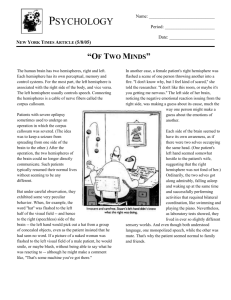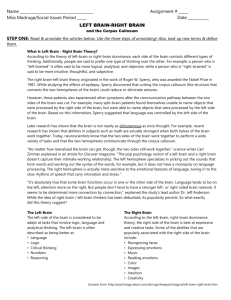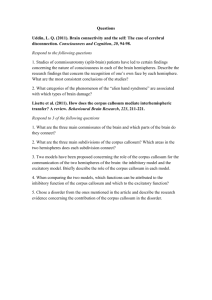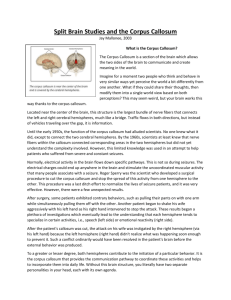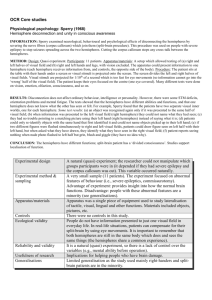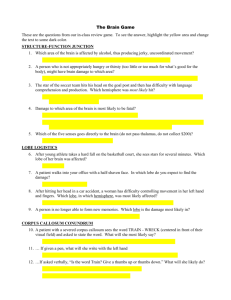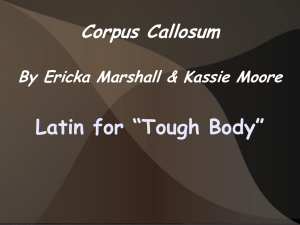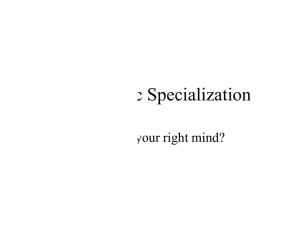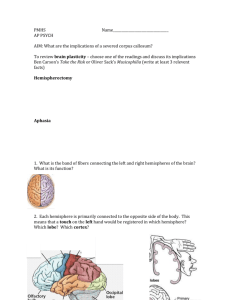Review of the split brain
advertisement
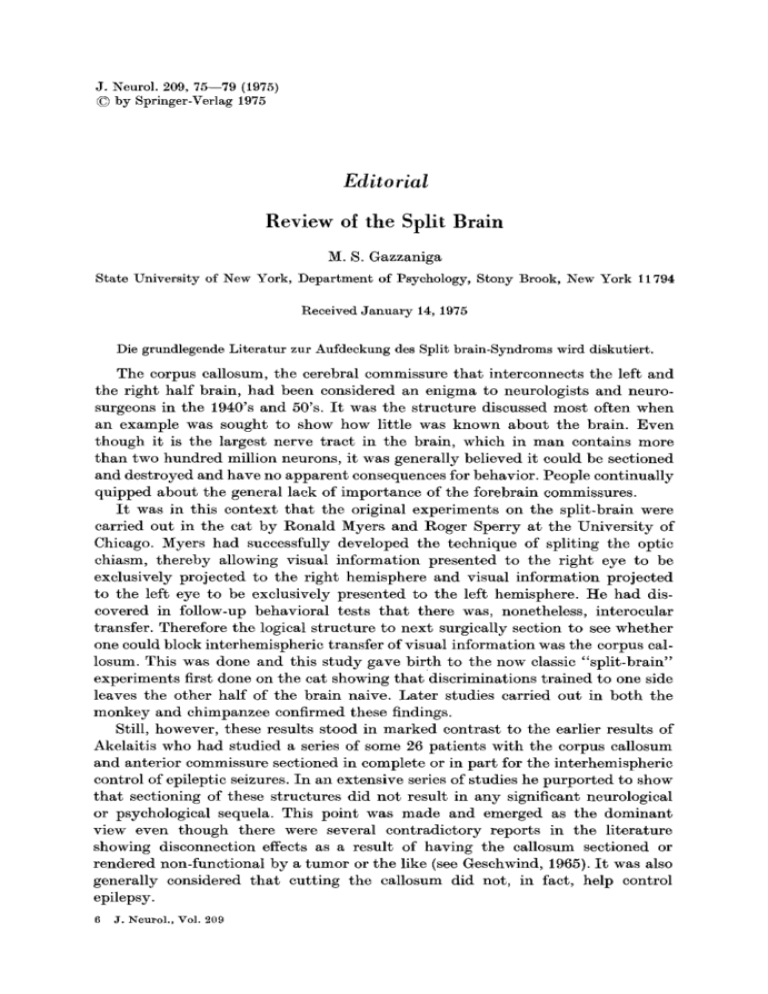
J. Neurol. 209, 75--79 (1975) © by Springer-Verlag 1975 Editorial Review of the Split Brain M. S. Gazzaniga State University of New York, Department of Psychology, Stony Brook, New York 11794 Received J a n u a r y 14, 1975 Die grundlegende Literatur zur Aufdeckung des Split brain-Syndroms wird diskutiert. The corpus callosum, the cerebral commissure that interconnects the left and the right half brain, had been considered an enigma to neurologists and neurosurgeons in the 1940's and 50's. I t was the structure discussed most often when an example was sought to show how little was known about the brain. Even though it is the largest nerve tract in the brain, which in man contains more than two hundred million neurons, it was generally believed it could be sectioned and destroyed and have no apparent consequences for behavior. People continually quipped about the general lack of importance of the forebrain commissures. I t was in this context that the original experiments on the split-brain were carried out in the cat by Ronald Myers and Roger Sperry at the University of Chicago. Myers had successfully developed the technique of spliting the optic chiasm, thereby allowing visual information presented to the right eye to be exclusively projected to the right hemisphere and visual information projected to the left eye to be exclusively presented to the left hemisphere. He had discovered in follow-up behavioral tests that there was, nonetheless, interocular transfer. Therefore the logical structure to next surgically section to see whether one could block interhemispherie transfer of visual information was the corpus callosum. This was done and this study gave birth to the now classic "split-brain" experiments first done on the cat showing that discriminations trained to one side leaves the other half of the brain naive. Later studies carried out in both the monkey and chimpanzee confirmed these findings. Still, however, these results stood in marked contrast to the earlier results of Akelaitis who had studied a series of some 26 patients with the corpus callosum and anterior commissure sectioned in complete or in part for the interhemispherie control of epileptic seizures. I n an extensive series of studies he purported to show that sectioning of these structures did not result in any significant neurological or psychological sequela. This point was made and emerged as the dominant view even though there were several contradictory reports in the literature showing disconnection effects as a result of having the callosum sectioned or rendered non-functional by a tumor or the like (see Geschwind, 1965). I t was also generally considered that cutting the callosum did not, in fact, help control epilepsy. 6 J. Neurol., Vol. 209 76 M.S. Gazzaniga Then, in 1960, Dr. Joseph Bogen, who at the time was a resident at White Memorial Hospital in Los Angeles, proposed, after a careful review of the Akelaitis' literature, that the brain be split for the purpose of controlling the interhemispheric spread of epilepsy. His hunch that the surgery should work proved largely correct. I t was his first patient, W. J., that was extensively studied both pre and postoperatively on a host of psychological tests that we devised at the California Institute of Technology (Gazzaniga et al., 1962, 1963, 1965; Gazzaniga and Sperry, 1967). In subsequent examination of patients in the Bogen series a variety of striking and dramatic effects were observed. Information Exchange between Cerebral Hemispheres To begin with, the interhcmispheric exchange of information was totally disrupted following commissurotomy such that visual, tactual, proprioceptive, auditory and olfactory information presented to one hemisphere could be processed and dealt with in that half brain, but these activities would go on outside the realm of awareness of the other half cerebrum. Thus, the work confirmed the earlier animal work by Myers and Sperry but was in a sense more dramatic in that all processes ongoing in the left hemisphere could be easily verbally described by the patients since it is the left hemisphere that normally possesses the natural language and speech mechanisms. Information presented to the right hemisphere went undescribed and it was only through using special testing techniques that we were able to discover that the right hemisphere also had a rich mental life and was capable of experiencing most of the phenomena appreciated by the left brain. Mental Properties of the Right Hemispheres Using non-verbal tests especially designed for the purpose, it was determined that the right hemisphere had some language, could initiate its own responses and could emote, learn, remember and do all the things of normal life without the left hemisphere knowing the why or what of it all. Thus, for example, a word could be flashed in the left visual field which is exclusively projected to the right hemisphere in m a n - - s u c h as "spoon" and the subject would say, " I did not see anything," but then subsequently would be able with the left hand to retrieve the object from a series placed out of view. When the correct object was indicated by the subject holding it in his hand, the experimenter would say, " W h a t is it you have in your hand ?" they would say, " I don't know." Here again "mind left" does not know. I t did not see the picture nor did it have access to the stereognostic or touch information from the left hand which is also exclusively projected to the right hemisphere. Yet clearly the right hemisphere knew it because it reacted appropriately to the correct stimulus and made the appropriate response. These patients, however, allow for even further studies that would allow the examiner to investigate the separate mental properties of the two half brains. We showed that the left hemisphere, as would be predicted from early clinical reports, excelled in verbal processing of information of all kinds. The right hemisphere, however, was superior in managing visual spatial tasks such as drawing cubes, arranging blocks to match designs and the like. This distribution of mental work Review of the Split Brain 77 in the brain highlights a major difference between man and animals and raises the intriguing possibility t h a t the various modes of consciousness have separate physical identities in the brain. These earlier results carried out on Bogen's series of patients have recently been confirmed and extended on the patients of Dr. Donald Wilson of the Dartmouth Medical School. Wilson, using a different surgical approach t h a n Bogen, has also carried out both complete and partial commissurotomies with the aim of preventing interhemispheric spread of epileptic seizures. Neuropsychological examination of these patients has confirmed m a n y of the earlier findings on the Bogen series and, in brief, pointed out t h a t visual, taetual, auditory and olfactory information cannot be transferred following forebrain commissurotomy. Moreover, the partial sectioned cases showed t h a t a surgical lesion can be made t h a t will block visual information from transferring between the two half brains but not tactile and vice versa. Interestingly, it seems to not matter which part of the callosum is in tact in order to realize transfer of what might be called the superordinate function of the two half brains. Thus, the specialized activities of the right m a y come to the aid of the left no matter what part of the callosum is intact ; whereas, more specific information from the right half brain, such as visual information in the left field, cannot be communicated to the left hemisphere if the splenium alone is sectioned. Tests on these patients also revealed t h a t there is a possibility t h a t one of the costs to an individual for having this seizure-controlling surgery, is t h a t the mental life of the left hemisphere m a y go on without the aid of the normal imaging mechanisms which are most likely normally housed on the right. Consistent with this is one of the complaints of the patients in the Bogen series t h a t they no longer dream. Dreaming reflects imaging processes and what has been traditionally called the subconscious process. I t would be fascinating to discover t h a t the right half brain is primarily responsible for this side of our mental life. A series of sleep research experiments is now being contemplated to confirm this possibility. I n the past, the amount of language and mental activity discovered in the right brain, in our earlier studies, was thought to be the product of early brain damage. I t is well known t h a t if brain damage occurs early in life, there is a bilateralization of the language and speech mechanisms. However, a recent case has been reported of a patient who, at the age of 70, suffered vascular disease which specifically affected the splenium with the results t h a t the person was a split-brain with respect to visual functions. This patient also showed the same language talents t h a t we had outlined earlier in the Bogen series of patients. This kind of evidence suggests t h a t in the normal developmental process there is some redundancy in the system such t h a t all of language or all of spatial functions are not strictly and exclusively lateralized to the respective left and right hemispheres. Educational Significance Indeed one of the intriguing possibilities coming from the split-brain research is the possibility t h a t man can be explicitly specialized for a variety of aspects 6* 78 M.S. Gazzaniga of m e n t a l life with superiorities in t h e v e r b a l a r e n a n o t necessarily m e a n i n g superiorities in t h e v i s u a l - s p a t i a l a n d vice versa. Thus, when dealing with a cognitive t a s k it m a y well prove to be the ease t h a t a p a r t i c u l a r child, for instance, m i g h t well be able to solve t h e p r o b l e m using v e r b a l symbols with g r e a t e r ease t h a n with visual, b u t t h a t a n o t h e r child m i g h t be b e t t e r off solving the p r o b l e m using v i s u a l - s p a t i a l relations. T h e m o t i v a t i o n a l aspect of this observation, of course, cannot be o v e r e m p h a sized. I f a child h a p p e n s to be t a l e n t e d for visual-spatial relations a n d is being forced into a curriculum t h a t emphasizes t h e v e r b a l a r t i e u l a t o r y modes of solving a c o n c e p t u a l p r o b l e m , he will e n c o u n t e r enormous f r u s t r a t i o n a n d difficulty which m a y result in a h o s t i l i t y t o w a r d s the t e a c h e r a n d t o w a r d s the learning process itself. I f t h e t e a c h e r was aware t h a t t h e child was specialized in these skills, t h e same p r o b l e m could be i n t r o d u c e d to him using these skills which would obviously bring t h e child in line with his special talents. Conversely, of course, the child with high v e r b a l skills m a y quite f r e q u e n t l y be unable to visualize his p r o b l e m s w i t h a s p a t i a l aspect. He would be f r u s t r a t e d if forced into these academic areas. I n this regard, of course, t h e more we u n d e r s t a n d a b o u t the b r a i n a n d t h e more we u n d e r s t a n d a b o u t t h e various kinds of cognitive processing systems we use in our n o r m a l m e n t a l life, the more clearly we can u n d e r s t a n d t h e c o m p o n e n t s of w h a t is n o r m a l l y called " i n t e l l i g e n t b e h a v i o r " . W e h a v e r e c e n t l y developed an a n i m a l m o d e l for intelligence which emphasizes t h e i m p o r t a n c e of the shortt e r m m e m o r y system. A t e s t can be designed t h a t , when c o m b i n e d with p a r t i c u l a r surgical lesions, can p r o d u c e s h o r t - t e r m m e m o r y deficits which has t h e result of m a k i n g t h e a n i m a l a p p e a r less b r i g h t t h a n his cage-mates. I n fact, w h a t is at stake, is m e r e l y how m a n y variables t h e animal can keep in m i n d in a given space of time. The exciting aspect of a t e s t of this kind, of course, is t h a t it operationalizes t h e q u a n t i t y of intelligence a n d as these tests develop t h e y can be specifically designed to diagnose a p a r t i c u l a r individual. W h e r e we hope to be going, of course, is to develop a series of tests t h a t will diagnose an i n d i v i d u a l with respect to his specific m e n t a l skills. I t is more t h a n likely t h a t we will find t h a t m a n y people m a y be s p a t i a l l y bright, v e r b a l l y dull or vice versa. Or m a y b e some of us h a v e a b e t t e r s h o r t - t e r m m e m o r y s y s t e m or h a v e a faster processing c a p a c i t y when dealing with certain kinds of symbols. Once identified, of course, the t e a c h e r would be e n o u r m o u s l y a i d e d in how to best p r e s e n t i n f o r m a t i o n ibr its s p e e d y c o m p r e h e n s i o n a n d use. Philosophical h n p l i e a t i o n s The m o r e general p o i n t of s p l i t - b r a i n research, of course, is t h a t t h e surgeon's knife has r e v e a l e d t h a t t h e brain can be s i m p l y a l t e r e d to produce a s t a t e which can best be described as allowing for the doubling of consciousness. R e s e a r c h of this k i n d encourages us to t h i n k in t e r m s of modes of consciousness. W h a t writers, poets a n d scientists h a v e been telling us fbr centuries seems true a n d t h e only difference b e t w e e n t h e s p l i t - b r a i n s u b j e c t a n d t h e n o r m a l is t h a t n o r m a l b y virtue of t h e callosum can switch between t h e various modes whereas t h e split experiences a real decoupling. L a s t l y , it would a p p e a r t h a t if we s t u d y t h e cerebral commissure t h a t gives us our n o r m a l s t a t e of conscious u n i t y , a n d grow to u n d e r s t a n d its neural physio- Review of the Split Brain 79 logical a n d n e u r o - a n a t o m i c a l m e c h a n i s m s m o r e fully, w e m i g h t well be closer t o u n d e r s t a n d i n g h o w n e u r o l o g i c a l s y s t e m s e n c o d e p s y c h o l o g i c a l i n f o r m a t i o n . I f we k n e w t h a t we w o u l d be a lot closer t o b r e a k i n g t h e c o d e o f t h e brain. References Akelaitis, A . J . : Psychobiological studies following section of the corpus callosum. A preliminary report. Amer. J. Psychiat. 97, 1147--1157 (1941a) Akelaitis, A. J. : Studies on the corpus callosum. II. The higher visual functions in each homonymous field following complete section of the corpus callosum. Arch. Neurol. Psychiat. (Chic.) 45, 788--796 (1941b) Akelaitis, A. J. : Studies on the corpus callosum. V. Homonymous defects for color, object and letter recognation (homonymous hemiamblyopia) before and after section of the corpus callosum. Arch. Neurol. Psychiat. (Chic.) 48, 108--118 (1942) Akelaitis, A. J., Risteen, W. A., Herren, R. ¥., van Wagenen, W. P.: Studies on the corpus callosum. III. A contribution to the study of dyspraxia in epileptics following partial and complete section of the corpus callosum. Arch. Neurol. Psychiat. (Chic.) 47, 971--1008 (1942) Bogen, J. E. : The other side of the brain. I: Dysgraphia and dyscopia following cerebral commissurotomy. Bull. Los Angeles neurol. Soc. 34, 73--105 (1969a) Bogen, J. E. : The other side of the brain. I I : appositional mind. Bull. Los Angeles neurol. Soc. 84, 135--162 (1969b) Bogen, J. E., Bogen, G. M. : The other side of the brain. I I I : The corpus callosum and creativity. Bull. Los Angeles neurol. Soc. 34, 191--217 (1969) Gazzaniga, M. S. : The bisected brain. New York: Appleton 1970 Gazzaniga, M. S. : Fundamentals of psychology. An introduction. New York-London • Academic Press 1973 Gazzaniga, M. S. : Partial commissurotomy and cerebral localization of function. In. Cerebral localisation (eds. K . J . Ziilch, 0. Creutzfeldt and G. Galbraith). Berlin-Heidelberg-New York: Springer 1975 (in press) Gazzaniga, M.S., Bogen, J . E . , Sperry, R. W. : Some functional effects of sectioning the cerebral commissures in man. Proc. nat. Acad. Sci. (Wash.) 48, 1765--1769 (1962) Gazzaniga, M.S., Bogen, J. E., Sperry, R . W . : Laterality effects in some thesis following cerebral commissurotemy in man. Neuropsychologia l, 209--215 (1963) Gazzaniga, M. S., Bogen, J. E., Sperry, R. W. : Observations on visual perception after disconnection of the cerebral hemispheres in man. Brain 88, 221--236 (1965) Gazzaniga, M. S., Sperry, R. W. : Language after section of the cerebral commissures. Brain 99, 131--348 (1967) Geschwind, N. : Disconnexion syndromes in animals and man. Brain 88, 237--294, 585--644 (1965) Myers, R. E. : Function of corpus callosum in interocular transfer. Brain 79, 358--363 (1956) Myers, R. E., Sperry, R. W. : Interhemispheric communication through the corpus callosum. Mnemonic carry-over between the hemispheres. Arch. Neurol. Psychiat. (Chlc.) 8l}, 298--303 (1958) Sperry, R. W. : Hemisphere deconnection and unity in conscious awareness. Amer. Psychologist 27, 723--733 (1968) Wilson, D. : 1973 in preparation Prof. Dr. M. S. Gazzaniga State University of New York at Stony Brook Department of Psychology Stony Brook, N. Y. 11794, USA
